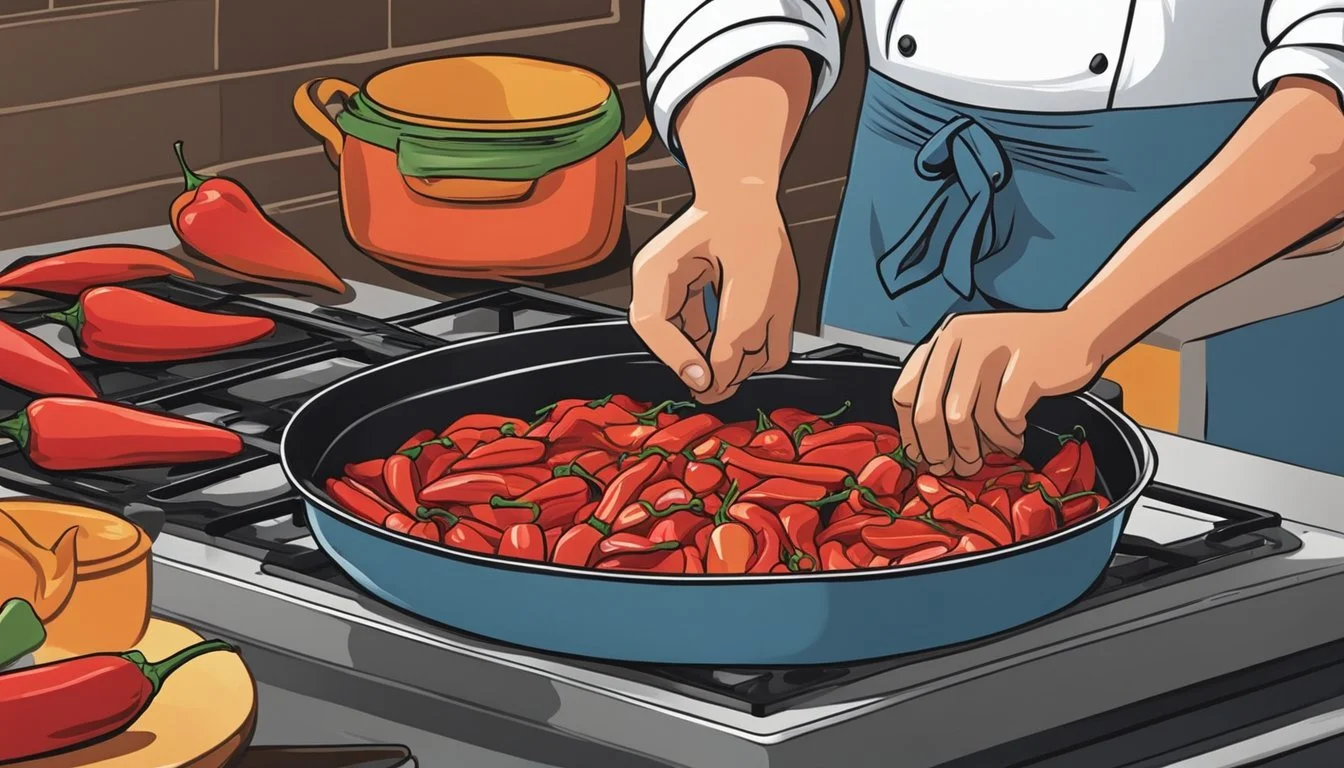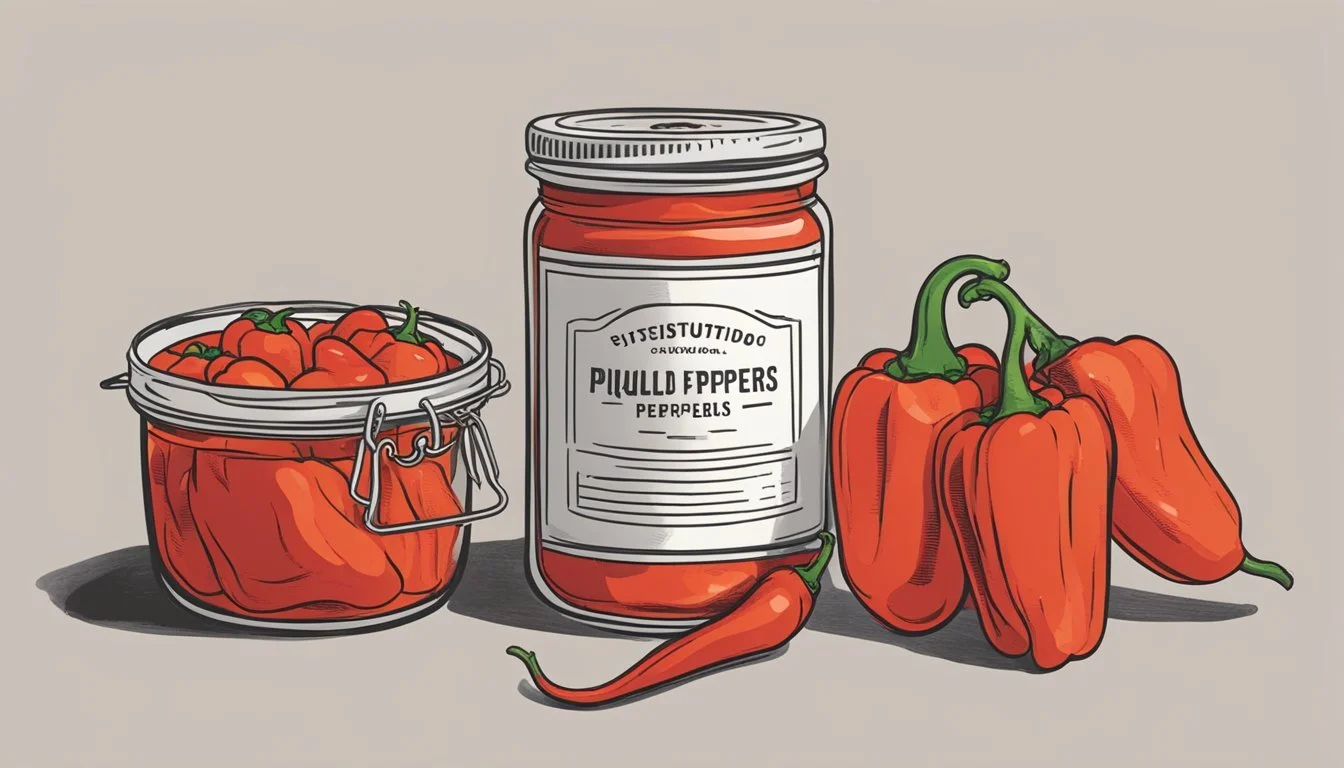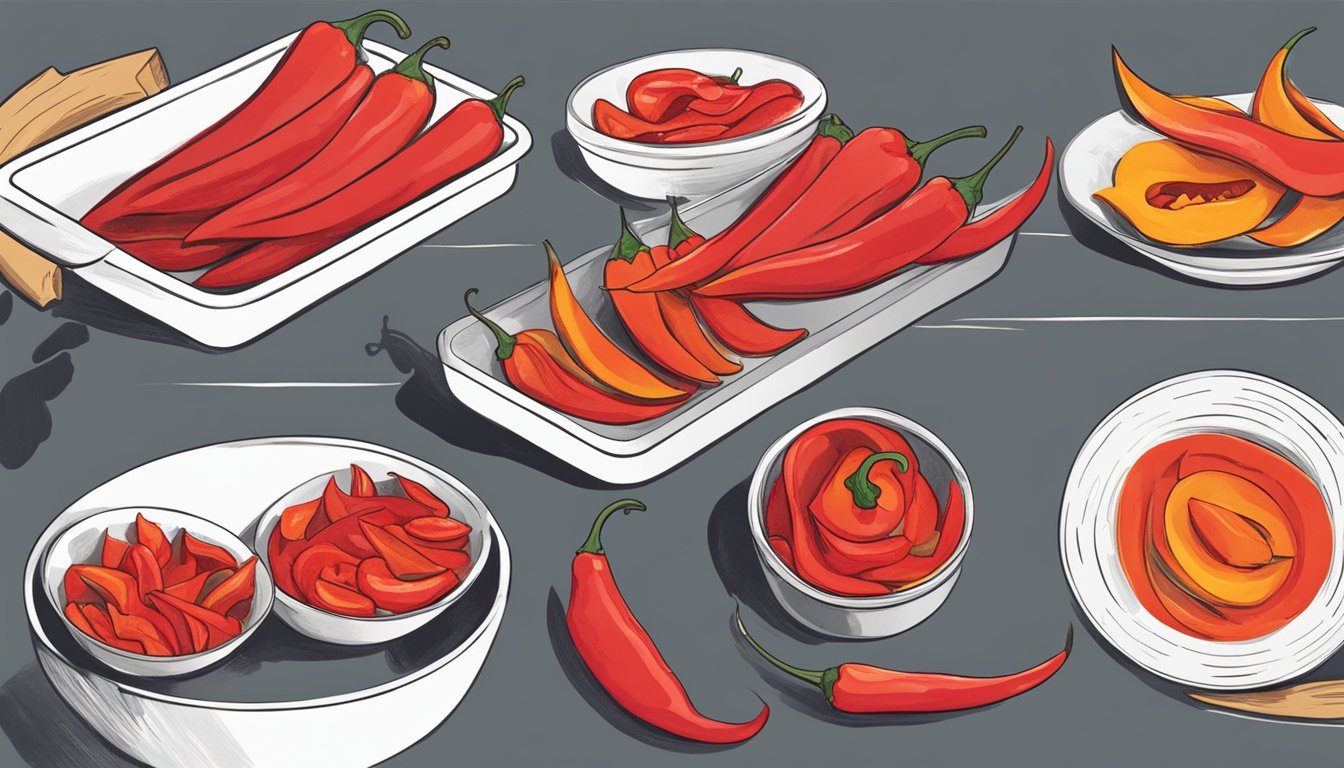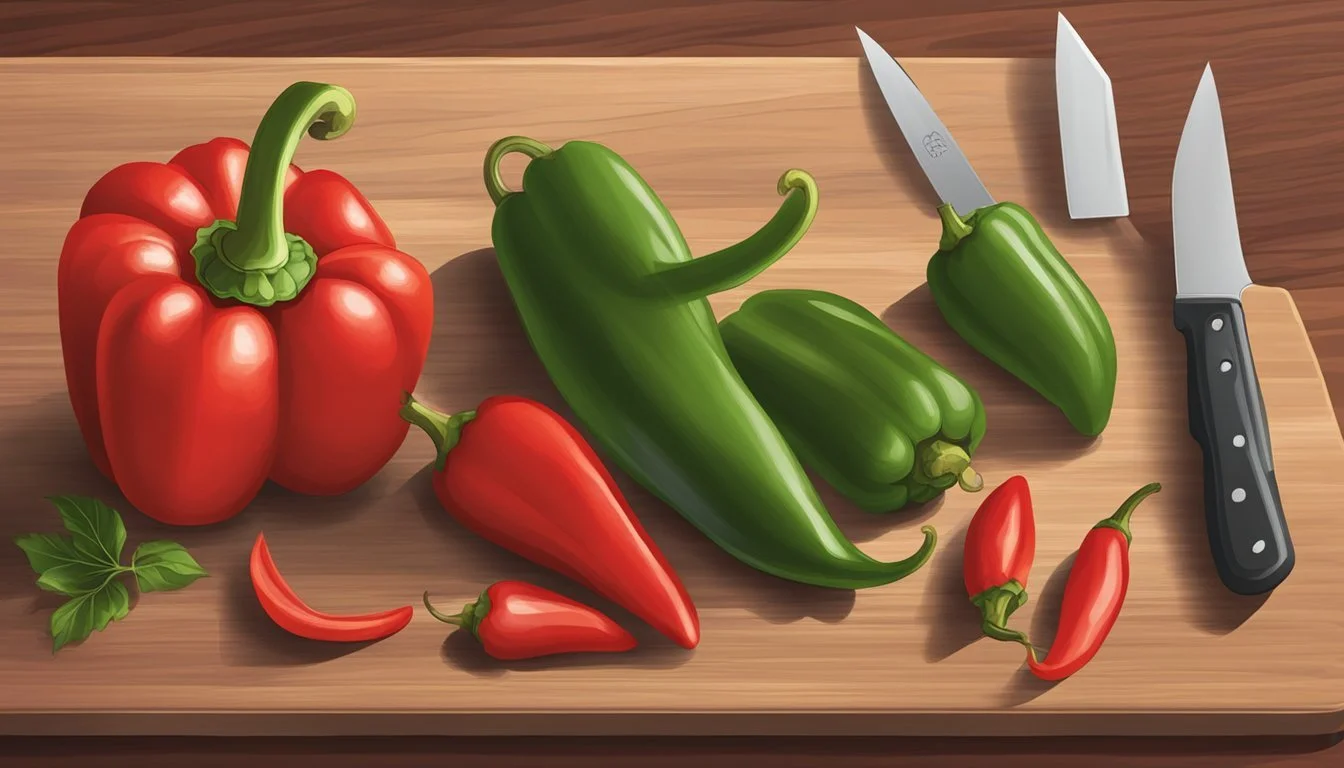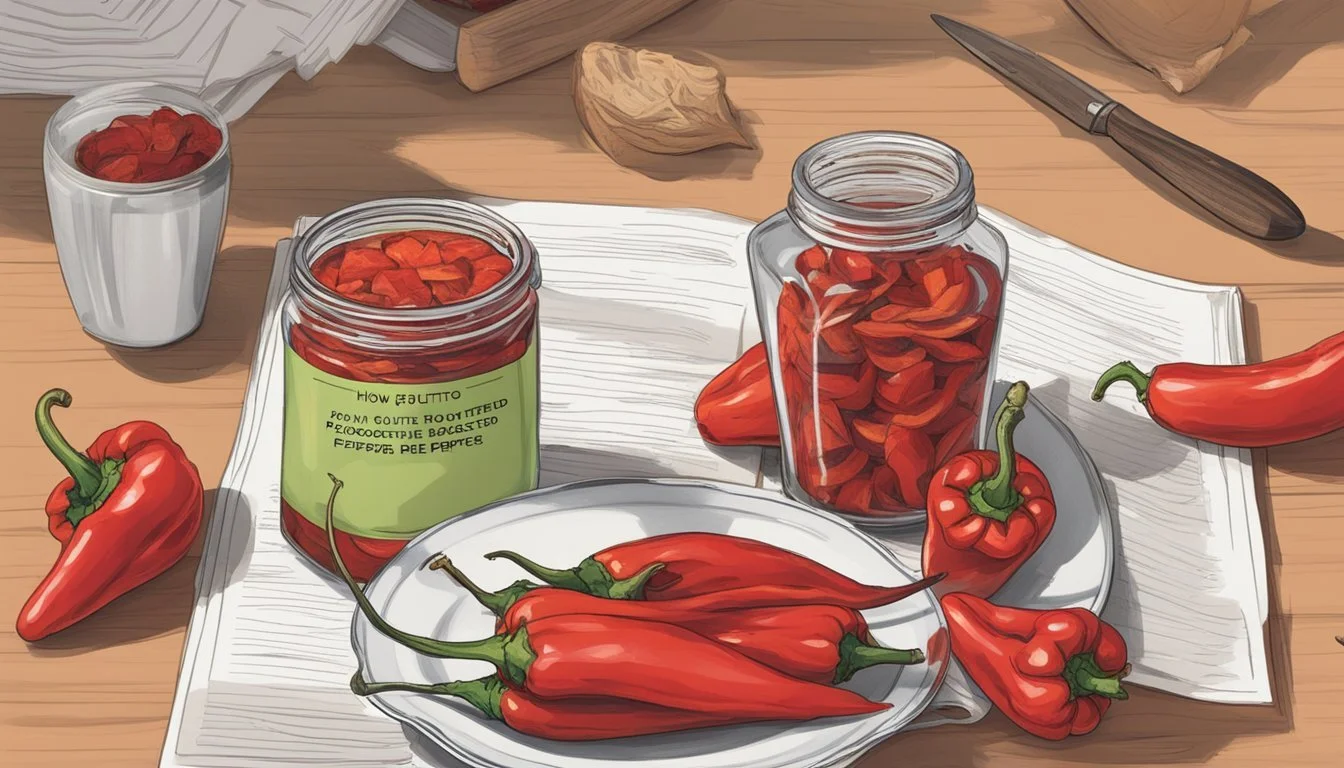How to Substitute Piquillo Peppers for Roasted Red Peppers
A Simple Guide
Piquillo peppers, with their distinct sweet and slightly spicy flavor, are a staple in Spanish cuisine, notably for their use in dishes such as stuffed peppers and tapas. Their unique taste is a product of the La Rioja region of Spain, where they are traditionally grown and prepared. However, piquillo peppers might not always be readily available in local markets outside of Spain, prompting culinary enthusiasts to seek alternatives.
Roasted red peppers offer a practical and widely accepted alternative when piquillo peppers are unavailable. The roasting process brings out the natural sweetness of red bell peppers, creating a flavor profile that approximates that of the piquillo pepper. Although roasted red peppers tend to be milder and slightly less sweet, they can complement many dishes where the piquillo's nuanced taste is desired.
When substituting roasted red peppers for piquillo peppers, it's essential to consider the texture and size. Roasted red peppers are typically larger and softer than piquillos. Adjusting the amount used and preparation method can ensure that the substitute maintains the integrity of the original dish. This substitution not only broadens the accessibility to the flavors of Spanish cuisine but also allows for the creation of new variations on classic recipes.
Understanding Piquillo Peppers
In this section, we delve into the unique characteristics of Piquillo peppers, from their origins to their culinary versatility and nutritional benefits.
Origins and Culinary Uses
Piquillo peppers are a staple of Spanish cuisine, particularly associated with the region of Navarra. Traditionally harvested by hand, these peppers are renowned for their use in dishes such as tapas. They are often stuffed with various fillings or served as part of a recipe that calls for a distinctive, sweet pepper.
Flavor Profile and Heat
The flavor profile of Piquillo peppers is notably sweet, with a slight spice that is less pronounced than many other chili varieties. On the Scoville scale, Piquillo peppers are relatively mild with a rating between 500 to 1,000 units. This mildness, combined with their unique sweetness, makes them a preferred ingredient in Spanish recipes to add complexity without overwhelming heat.
Nutritional Value
Piquillo peppers are not only prized for their flavor but also for their nutritional content. They are rich in Vitamin C and Vitamin A, both essential nutrients for maintaining good health. The peppers' concentrated amounts of these vitamins can be attributed to their bright red hue, indicative of their ripeness and antioxidant properties.
Choosing Substitutes for Piquillo Peppers
When seeking a substitute for Piquillo peppers, one should consider both the flavor profile and the heat level of the alternatives. The right substitute can offer a similar sweet and smoky taste with a mild heat that complements a variety of dishes.
Alternative Pepper Varieties
Several pepper varieties can be used as substitutes for Piquillo peppers, each offering a different balance of sweetness and heat. Noteworthy options include:
Red Bell Peppers: These peppers provide a sweet flavor without any heat, making them a readily available option. They lack the smokiness of Piquillo peppers, but roasting can enhance their taste.
Fresno Peppers: Offering a slight smokiness with medium heat, Fresnos can be used when a bit more spice is preferred. They should be roasted for the best flavor match.
Banana Peppers: These are milder and sweeter, ideal for those who seek minimal heat. Select the ripest for a closer flavor approximation.
Jalapeño Peppers: A commonly used pepper with moderate heat and a fruity note. Adjust the quantity to match the desired heat level.
Pepper Type Flavor Notes Heat Level (Scoville Scale) Red Bell Pepper Sweet 0 SHU Fresno Pepper Slightly sweet and smoky 2,500–10,000 SHU Banana Pepper Mild, sweet 0–500 SHU Jalapeño Pepper Spicy, slightly fruity 2,500–8,000 SHU
Considering Flavor and Heat
The Scoville Scale measures the heat of peppers. Piquillo peppers fall between 500 to 1,000 Scoville Heat Units (SHU), categorizing them as mild. When substituting, one must consider both the flavor and heat to maintain the integrity of the dish. For example, Red Bell Peppers are heatless and sweet, with no spiciness, making them a good alternative for dishes where no heat is desired. For a subtle kick, one might opt for Fresno or Jalapeño Peppers, keeping the quantity low to mimic Piquillo's mildness. Banana Peppers, too, are mild and can substitute well for Piquillo Peppers without significantly altering the heat profile of a dish.
Preparing Roasted Red Peppers as a Substitute
When substituting piquillo peppers with roasted red peppers, one should focus on replicating the former's distinct sweet and mildly spicy flavor profile. The objective is to create a roasted red pepper with a balanced taste that can complement dishes in a similar manner to piquillo peppers.
Roasting Techniques
To begin, one selects fresh, firm bell peppers from the grocery store. They are then washed, halved, and de-seeded. The halves are placed skin-side up on a baking sheet and roasted under a broiler or oven set to a high temperature, usually around 450°F (232°C), until the skins blister and char. This typically takes about 15-20 minutes. Once blackened, they are enclosed in a bowl covered with plastic wrap to steam, which makes the skin easier to peel off.
Seasoning Adjustments
A roasted red pepper lacks the natural smokiness of a piquillo pepper. To compensate, one can lightly dust the peppers with smoked paprika or sumac for added depth of flavor. Moreover, seasoning with salt is recommended to enhance the sweet undertones. A splash of vinegar can also be added to provide the subtle acidic kick found in piquillo peppers.
Storage and Preservation
After roasting and peeling, if the peppers are not used immediately, they can be stored in a jar covered with olive oil. It is essential to ensure that the peppers are fully submerged to prevent spoilage. Refrigerated roasted red peppers can last up to two weeks. Alternatively, jarred roasted red peppers available at grocery stores serve as a convenient and time-efficient substitute, although they may require draining and patting dry to remove excess brine before use.
Integration in Recipes
When substituting piquillo peppers for roasted red peppers in recipes, attention must be paid to the dish's flavor profile and the desired texture. Roasted red peppers can deliver a similar sweetness and char to dishes, though they are typically less firm than piquillo peppers.
Stuffed Pepper Dishes
In stuffed pepper dishes, such as tapas or appetizers, the robust structure of a piquillo pepper is ideal for holding fillings like chorizo, goat cheese, or sausages. A suitable substitute would be a pepper that can retain its shape through the baking process. One should consider using bell peppers as they are readily available and hold stuffing well without disintegrating too easily during cooking.
Sauces and Toppings
For sauces and toppings, such as those used in paella or as a garnish, the type of substitute will hinge on the desired texture and flavor complexity. If piquillo peppers are meant to add a touch of sweetness or to be featured as pimentos, a mild yet flavorful alternative like cherry peppers may serve well. Smoked paprika can also be used to mimic the smoky taste if only the flavor needs to be replicated.
Salads, Soups, and Stews
In salads, soups, and stews, the pepper's role varies from a key ingredient to a subtle enhancement. When piquillo peppers are sought for their slight heat and sweet notes in a salad, one could integrate banana peppers for a comparable effect. For soups and stews that require the pepper to imbue the dish with a deeper flavor, roasted red peppers work splendidly as they soften beautifully when simmered, complementing the overall texture.
Adjusting for Texture and Presentation
When substituting piquillo peppers for roasted red peppers, chefs need to pay close attention to texture and presentation, as these aspects are crucial in culinary applications. Traditionally, piquillo peppers are known for their firm texture, which is ideal for making stuffed piquillo peppers.
Texture:
Piquillo Peppers: Known for their distinct firmness, ideal to hold stuffing.
Roasted Red Peppers: Tend to be softer, which may result in a less-defined shape when used for stuffing.
For dishes that require a firmer texture similar to piquillo peppers, consider the following steps:
Pat dry the roasted red peppers after removing them from the brine to remove excess moisture.
Briefly roast in an oven to enhance firmness and flavor.
If necessary, use toothpicks to maintain the structure of the dish.
Presentation:
For garnish, presentation differs significantly:
Piquillo Peppers: Bright red with a smooth complexion, suitable as an eye-catching garnish.
Roasted Red Peppers: While still vibrant, they may lack the uniformity of piquillo peppers.
If using roasted red peppers as a garnish, chefs can cut them into fine strips to mimic the aesthetic of piquillo peppers, keeping the dish visually appealing.
Here's a tabular summary:
Aspect Piquillo Pepper Roasted Red Pepper Texture Firm, holds its shape well Softer, may require additional prep Usage in Stuffing Excellent for stuffing Use techniques to improve firmness Appearance as Garnish Uniform, bright, smooth Strips can mimic piquillo's appeal
Adapting to the nuances in texture and presentation ensures the integrity of the dish when making pepper substitutions.
Understanding Heat Levels
When substituting piquillo peppers for roasted red peppers, it is critical to grasp the heat differences between various pepper varieties to achieve the desired flavor profile.
Scoville Scale and Pepper Heat
The Scoville scale is the definitive measurement of the spiciness of chili peppers, expressed in Scoville Heat Units (SHU). This scale gauges the capsaicin concentration, which is the chemical responsible for the spicy sensation. For example:
Bell Peppers: 0 SHU (no heat)
Piquillo Peppers: 500-1,000 SHU (mild heat)
Jalapeño Peppers: 2,500-8,000 SHU (moderate heat)
Cayenne Pepper: 30,000-50,000 SHU (hot)
Roasted red peppers typically refer to roasted bell peppers, which do not contain capsaicin and are therefore not spicy. Their use as a substitute for piquillo peppers would not add heat to a dish but can contribute a similar sweet and smoky flavor.
Mild vs. Hot Pepper Substitutes
When choosing a substitute based on heat levels, consider whether the recipe calls for a mild or hot pepper:
Mild Pepper Substitutes: Pimento peppers, which are akin to bell peppers, carry a negligible amount of heat and can replicate the mild warmth of piquillo peppers.
Hot Pepper Substitutes: Those looking for a spicier alternative might opt for jalapeño or cayenne peppers, but these should be used with caution due to their higher SHU.
In summary, while selecting substitutes for piquillo peppers, the Scoville scale serves as a guide to match the desired heat intensity and can help ensure that the recipe maintains its intended flavor balance.
Finding Piquillo Peppers and Their Substitutes
For those who enjoy the distinct, sweet and slightly spicy flavor of piquillo peppers, sourcing these peppers is a priority in authentic culinary creations. When unavailable, certain substitutes can provide a similar flavor profile and are accessible through various outlets.
Grocery Stores and Specialty Shops
Grocery Stores: It is common for grocery stores to stock piquillo peppers in the international or specialty foods aisle. Typically, they are available in jars, preserved in brine or olive oil. Look for labels indicating "piquillo" to ensure authenticity. For those seeking a substitute, roasted red bell peppers can often be found in the same aisle, offering a sweeter but comparably versatile alternative.
Specialty Shops: Specialty shops, particularly those focusing on Spanish or Mediterranean cuisines, are more likely to carry gourmet selections of piquillo peppers. These peppers may come in different preparations, such as whole, sliced or even stuffed. They may also provide high-quality substitutes like ancho or guajillo chiles which can bring a smoky depth to dishes.
Online Vendors and Local Markets
Online Vendors: The online marketplace broadens the availability of piquillo peppers and their substitutes. Many vendors sell jars of piquillo peppers, and shoppers can often purchase them in bulk. This avenue also provides access to a wider variety of substitutes, including dried and specialty peppers that might be harder to find in local stores.
Local Markets: Local farmers' markets and specialty food markets sometimes offer fresh piquillo peppers, especially during their growing season. One might also encounter locally produced substitutes like freshly roasted peppers or artisanal sauces that can serve as an alternative in recipes calling for piquillo peppers. These local offerings can vary seasonally and regionally, presenting opportunities to explore new flavors and preparations.
Final Thoughts
When one seeks to substitute piquillo peppers in a culinary context, roasted red peppers stand as a commendable alternative. Roasted red peppers offer a versatile flavor profile, marked by a sweetness and a slight charring that mirrors the essence of piquillo peppers. It’s worth noting that while they share similar tastes, roasted red peppers are more widely accessible and can be found in most grocery stores, making them a practical swap.
Key Considerations for Substitution:
Flavor: Roasted red peppers have a gentle heat and a pronounced sweetness that approximates the unique taste of piquillo peppers.
Texture: They should be finely chopped or sliced to match the tender consistency of piquillo peppers.
Quantity: One should be attentive to the quantity used; typically, half a roasted red pepper equates to one piquillo pepper.
Preparation Tips:
To enhance the substitution, one may employ a hint of smoked paprika, which will impart a depth of flavor akin to piquillo peppers.
If store-bought, ensure they are well-drained to avoid excess moisture.
In culinary applications where piquillo peppers are not the centerpiece but rather a complement to a dish, roasted red peppers can be seamlessly integrated. Chefs may adjust the seasoning to suit the desired flavor intensity. They should acknowledge that while a discerning palate might detect the slight variance in sweetness and smokiness, roasted red peppers are an excellent substitute that maintains the integrity of the dish.
Frequently Asked Questions
In this section, readers will find specific information on the practical considerations when substituting piquillo peppers for roasted red peppers, addressing ratios, allergenic concerns, and how to maintain freshness and longevity of the peppers.
Substitution Ratios
When substituting roasted red peppers for piquillo peppers, one should consider the intensity of flavor and size. Typically, a 1:1 volume ratio is acceptable, as roasted red peppers provide a similar sweet and smoky profile. However, since piquillo peppers are smaller, two piquillo peppers are roughly equivalent to one medium-sized roasted red pepper.
Pepper Allergy Concerns
When recommending substitutes for piquillo peppers, it's important to be aware of potential pepper allergies. Bell peppers are in the nightshade family and may elicit an allergic response in sensitive individuals. Therefore, always advise checking for allergies before choosing roasted red peppers as a substitute, as they share the same family.
Preservation and Shelf Life
Roasted red peppers can be preserved to extend their shelf life. Store them in an airtight container with olive oil, and a pinch of salt can enhance their natural sweetness and act as a preservative. Ensure proper refrigeration to keep them edible for up to two weeks. If bought in a jarred form or canned with preservatives, they can last unopened for months when stored in a cool, dark place.
References and Additional Reading
When exploring substitutes for Piquillo peppers, roasted red peppers are a common recommendation. Individuals interested in further information on suitable replacements and their culinary applications can consult the following resources:
Cooking Blogs and Food Websites: These platforms often provide detailed explanations and recipes that highlight the nuances of using substitutes like roasted red peppers. Searching for "Piquillo pepper substitutes" will yield a variety of dedicated articles.
Culinary Books: Look for volumes on Spanish cuisine or vegetable-focused cookbooks. Specific titles may not be listed here, but a library or bookstore's gastronomy section is frequently a treasure trove of such information.
Online Cooking Forums: Community discussions can offer practical advice and personal experiences about substituting Piquillo peppers, especially in forums geared toward professional chefs or specific cuisine enthusiasts.
Handy Table for Quick Reference:
Substitute Flavor Profile Heat Level Usage Ratio Roasted Red Peppers Mild, sweet, with a hint of char None to Mild 1:1 for Piquillo peppers Jalapeno Peppers Spicy with a fruity taste Medium to Hot Adjust to taste Bell Peppers Sweet and mild None May use more to match flavor intensity Cherry Peppers Mild, sweet, and slightly spicy Mild Similar to Piquillo in size 1:1 Smoked Paprika Smoky, sweet None Use sparingly as a seasoning
One should consider the desired flavor profile and heat level when choosing a substitute, as the chosen pepper will impart its unique characteristics to the dish.
For those seeking more scholarly information, academic articles on food science may provide insights into the chemical composition of Piquillo peppers and their substitutes, aiding in understanding their interchangeable use in cooking.
Interested readers can always look to local culinary classes or workshops, which may offer hands-on experience with Piquillo peppers and their alternatives, under the guidance of professional chefs.

